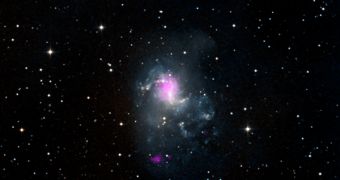The existence of intermediate-size black holes has been hypothesized some time ago, but thus far experts have been unable to find even a single one of these structures. In a new study, astronomers at NASA look at a series of objects, known as ultra-luminous X-ray sources, as potential candidates.
The investigation was conducted using the NASA Nuclear Spectroscopic Telescope Array (NuSTAR) observatory in Earth's orbit. Experts say that ULX are radiation sources that consist of a small-sized black hole (weighing a maximum of 10 solar masses) and a companion star on which it feeds.
In this process, material is funneled from the surface of the companion star into the black hole, and the process generates vast volumes of radiations at multiple wavelengths across the spectrum. Some experts have suggested that these ULX may in fact host intermediate-sized black holes.
The issue here is that the Universe appears to be lacking black holes with moderate masses. Small ones weigh just 10 solar masses, sometimes even less, while the supermassive variety can exceed weights of 10 billion solar masses. But researchers have never seen a black hole weighing 1,000 solar masses, or 10 million solar masses, for example.
Several classes of cosmic objects have been proposed as potential intermediate-size black holes. ULX are the latest such proposal, which is why NuSTAR conducted the new study. “Exactly how intermediate-sized black holes would form remains an open issue,” says researcher Dominic Walton.
“Some theories suggest they could form in rich, dense clusters of stars through repeated mergers, but there are a lot of questions left to be answered,” adds the expert, who holds an appointment at the California Institute of Technology (Caltech), in Pasadena.
Unlike supermassive black holes, ULX (as potential IMBH) lie throughout galaxies. Theories explaining medium-sized black holes suggest that these objects should be significantly more common than their supermassive counterparts that lie at the center of galaxies.
The NuSTAR study was focused on a previously-unknown ULX located some 13 million light-years away from Earth, in the Circinus. Caltech researchers found that the X-ray source was harboring a black hole about 100 times the mass of the Sun, which means that it lies exactly on the theoretical border between small and medium black holes.
Additional datasets for the research were collected by the European Space Agency's (ESA) XMM-Newton satellite and the NASA Chandra X-ray Observatory, the Swift Gamma-Ray Burst Mission and the Spitzer Space Telescope. Details of the study will be published in the Astrophysical Journal soon.

 14 DAY TRIAL //
14 DAY TRIAL //